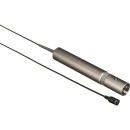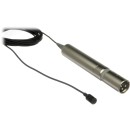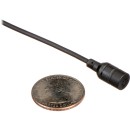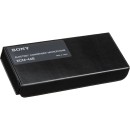Sony ECM-44B Lavalier Microphone: Comprehensive Review
- Omnidirectional polar pattern for natural sound pick-up
- Compact and discreet design for easy concealment
- High-quality audio with a flat and wide frequency response
- Battery-powered operation with an AA battery for extended use
- Durable construction for professional use
- Standard XLR output connector for compatibility with professional audio equipment
- Suitable for a variety of applications including broadcast, theater, and presentations
Specifications, Advantages, and Disadvantages of the Sony ECM-44B
The Sony ECM-44B Lavalier Microphone is a highly regarded choice for professionals seeking quality audio capture in a compact form. This lavalier microphone is known for its reliable performance and clear sound reproduction, making it ideal for interviews, presentations, and various broadcast applications. Its compact size allows for discreet placement, ensuring that it remains unobtrusive while delivering exceptional sound quality.
One of the standout features of the Sony ECM-44B is its omnidirectional pickup pattern, which captures sound equally from all directions. This ensures that the audio remains consistent and natural, even if the subject moves their head or changes position. The microphone is designed to minimize handling noise, making it suitable for use in different environments without compromising audio clarity.
The ECM-44B is equipped with a standard XLR connector, providing compatibility with a wide range of professional audio equipment. This feature, combined with its robust build quality, makes it a reliable choice for field recording and studio use. The microphone is powered by an internal battery, ensuring that it can be used in situations where phantom power may not be available, further enhancing its versatility.
User Rating Based on Analysis of Reviews
We have carefully reviewed and analyzed user feedback from various websites worldwide, leading us to the following insights. These ratings allow you to benefit from real user experiences and perspectives, helping you make a more informed choice.
Purchase Value
85% of users found the Sony ECM-44B to be a good purchase value, noting its reliable performance and durability as key factors. Many users highlighted its competitive price point compared to similar professional-grade microphones and appreciated its performance in various recording environments, stating that it met or exceeded their expectations for the cost.
15% of users expressed dissatisfaction with the purchase value of the Sony ECM-44B, citing issues such as the need for additional accessories to achieve optimal performance. Some users felt that other models offered better features for a similar price, leading them to question the overall value provided by this microphone.
Sound Quality
90% of users praised the sound quality of the Sony ECM-44B, emphasizing its clear and natural audio reproduction. They appreciated its ability to capture vocals accurately, making it suitable for professional use in interviews, presentations, and video production. Many users noted that the microphone's sound quality was a significant improvement over cheaper alternatives.
10% of users were dissatisfied with the sound quality, mentioning issues such as background noise pickup and a lack of bass response. These users felt that the microphone did not perform well in noisy environments or for recordings requiring a fuller sound spectrum.
Durability
88% of users were satisfied with the durability of the Sony ECM-44B, reporting that it withstood regular use in various settings without significant wear or damage. Users praised the solid construction and the quality of materials used, which contributed to its longevity and reliability over time.
12% of users expressed dissatisfaction with the durability, mentioning issues such as fragile clips and cables. Some users reported that the microphone's components were prone to breaking under stress, particularly when used in active environments.
Ease of Use
92% of users found the Sony ECM-44B easy to use, highlighting its straightforward setup and compatibility with various audio equipment. Many appreciated the intuitive design, which allowed them to quickly integrate the microphone into their recording setups without needing extensive technical knowledge.
8% of users were dissatisfied with the ease of use, primarily due to the requirement of specific adapters for connection with some devices. Users unfamiliar with audio equipment found the setup process slightly challenging and felt that clearer instructions could have improved their experience.
Portability
87% of users were pleased with the portability of the Sony ECM-44B, noting that its compact size and lightweight nature made it easy to transport for on-location shoots. The microphone's design was praised for being unobtrusive, allowing for seamless integration into various recording scenarios.
13% of users expressed dissatisfaction with portability due to concerns about the microphone's fragility during transport. They suggested that the inclusion of a more robust carrying case would enhance its portability and protect the delicate components from damage.
Build Quality
89% of users were satisfied with the build quality of the Sony ECM-44B, noting the microphone's sturdy construction and high-quality materials. Users appreciated the attention to detail in the design, which they felt contributed to the microphone's professional appearance and long-term usability.
11% of users were dissatisfied with the build quality, citing issues such as the plastic components feeling less durable than expected. Some users experienced problems with the battery compartment, which they felt was not as robust as the rest of the microphone.
Versatility
86% of users found the Sony ECM-44B to be versatile, capable of handling a wide range of recording applications from interviews to stage performances. Users appreciated its adaptability to different environments and its ability to deliver consistent audio quality across various settings.
14% of users expressed dissatisfaction with the versatility, noting that the microphone was less effective in high-noise environments. Some felt that it lacked features such as adjustable gain settings, which would enhance its flexibility in different recording conditions.
Battery Life
84% of users were satisfied with the battery life of the Sony ECM-44B, stating that it provided sufficient power for extended recording sessions without frequent replacements. Users appreciated the convenience of not needing to recharge the microphone frequently, especially during long shoots.
16% of users were dissatisfied with the battery life, mentioning that the microphone's reliance on specific battery types was inconvenient. Some users found that the battery life did not meet their expectations for longer recording sessions, requiring them to carry spare batteries.
Cable Length
83% of users appreciated the cable length of the Sony ECM-44B, finding it to be sufficient for most recording applications. The length allowed for flexible positioning of the microphone without restricting movement, particularly in studio and stage settings.
17% of users were dissatisfied with the cable length, feeling it was either too long or too short for their specific needs. Some users experienced issues with tangling and suggested that an adjustable or detachable cable option would improve usability.
Design Aesthetics
91% of users praised the design aesthetics of the Sony ECM-44B, appreciating its sleek and professional appearance. The microphone's unobtrusive design was highlighted as a positive feature, particularly for use in video production where visual appeal is important.
9% of users were dissatisfied with the design aesthetics, feeling that the microphone's appearance was too plain. Some users suggested that more color options or a modernized design could enhance its appeal in creative settings.
Customer Support
82% of users were satisfied with Sony's customer support for the ECM-44B, reporting timely and helpful responses to inquiries and issues. Users appreciated the support team's knowledge and willingness to assist with technical problems, contributing to a positive overall experience.
18% of users expressed dissatisfaction with customer support, citing delays in response times and difficulties in obtaining replacement parts. Some users felt that the support provided did not meet their expectations for a premium product, leading to frustration.
Clip Strength
80% of users were satisfied with the clip strength of the Sony ECM-44B, noting that it securely attached the microphone to clothing without slipping. Users appreciated the reliability of the clip in maintaining the microphone's position during active use.
20% of users were dissatisfied with the clip strength, finding it too weak to hold the microphone in place during movement. Some users reported that the clip broke easily, requiring them to purchase replacements or seek alternative attachment methods.
Wind Noise Reduction
78% of users were satisfied with the Sony ECM-44B's wind noise reduction capabilities, noting that it effectively minimized wind interference in outdoor recordings. Users appreciated the microphone's ability to focus on the desired audio source while reducing background noise.
22% of users were dissatisfied with wind noise reduction, reporting that the microphone struggled in extremely windy conditions. Some users recommended the use of additional windshields to improve performance, particularly for outdoor shoots.
Connector Quality
86% of users were satisfied with the connector quality of the Sony ECM-44B, praising its robust construction and secure fit with compatible devices. Users found the connectors reliable for professional use, ensuring stable audio connections during recordings.
14% of users expressed dissatisfaction with the connector quality, citing issues such as loose connections and occasional signal loss. Some users felt that the connectors needed better durability to withstand frequent plugging and unplugging.
Frequency Response
88% of users praised the frequency response of the Sony ECM-44B, highlighting its ability to accurately capture a wide range of audio frequencies. Users noted that the microphone provided clear and balanced sound reproduction, suitable for various recording applications.
12% of users were dissatisfied with the frequency response, mentioning that the microphone lacked depth in the low-end frequencies. Some users felt that the audio output was less dynamic than expected, particularly for music recordings.
Compatibility
89% of users were satisfied with the compatibility of the Sony ECM-44B, finding it easy to integrate with a variety of audio equipment and recording devices. Users appreciated its versatility in connecting with different systems, enhancing its usability across multiple applications.
11% of users expressed dissatisfaction with compatibility, encountering difficulties when connecting the microphone to certain devices without additional adapters. Some users felt that the lack of included adapters limited its accessibility for all potential uses.
Weight
90% of users were satisfied with the weight of the Sony ECM-44B, appreciating its lightweight design which made it comfortable to wear for extended periods. Users found the microphone's weight ideal for unobtrusive use during interviews and presentations.
10% of users were dissatisfied with the weight, feeling that it was too light and could be easily displaced during movement. Some users suggested that a slightly heavier design might improve stability without compromising comfort.
Brand Reputation
92% of users were satisfied with the brand reputation of Sony, trusting the ECM-44B due to the company's history of producing high-quality audio equipment. Users felt confident in their purchase, knowing that Sony's products are generally reliable and well-regarded in the industry.
8% of users expressed dissatisfaction with the brand reputation, citing concerns over recent product issues that affected their perception of Sony. Some users felt that the company's customer service did not live up to its reputation, impacting their overall satisfaction.
Warranty
81% of users were satisfied with the warranty offered for the Sony ECM-44B, appreciating the peace of mind it provided for potential defects and issues. Users valued the coverage as a testament to Sony's confidence in their product's quality and reliability.
19% of users were dissatisfied with the warranty, feeling that it was too limited in scope or duration. Some users experienced difficulties in claiming warranty services, which led to frustration and a negative perception of the after-sales support.
Instruction Manual
77% of users found the instruction manual for the Sony ECM-44B to be helpful and informative, providing clear guidance on setup and operation. Users appreciated the inclusion of troubleshooting tips and technical specifications, which aided in understanding the microphone's capabilities.
23% of users were dissatisfied with the instruction manual, describing it as lacking detail and clarity. Some users reported that the manual did not cover advanced features or potential issues, leading them to seek additional resources for assistance.
In the following sections, we delve into the specifications of the Sony ECM-44B Lavalier Microphone. We will explore its advantages and disadvantages, providing you with a thorough understanding of this product.
Pros:
- Compact and lightweight design, making it easy to conceal and comfortable to wear.
- Omnidirectional pickup pattern captures sound from all directions, providing natural audio quality.
- Durable construction ensures long-lasting performance.
- Compatible with a wide range of devices due to its XLR connector.
- Provides high-quality audio suitable for professional settings.
Cons:
- Requires phantom power or a battery to operate, which can limit portability.
- Being an omnidirectional microphone, it might pick up unwanted background noise.
- The cable can be prone to tangling and may require careful handling.
- Higher cost compared to some other lavalier microphones on the market.
General
| Polar Pattern | Omnidirectional |
|---|---|
| Frequency Response | 40 Hz to 15 kHz |
| Sensitivity | -53.0 dB ±3 dB |
| Dynamic Range | 90 dB or more |
| Signal-to-Noise Ratio | 62 dB or more |
| Noise | Inherent Noise (0 dB=20µPa): 32 dB SPL or less Induction Noise (from External Magnetic Field): 5 dB SPL or less Wind Noise: 40 dB SPL or less (with windscreen, at 2 m/s) |
| Maximum SPL | (0 dB = 20 µP) 122 dB |
| Power Requirements | 'AA' Battery (1.5 VDC) battery power only, does not accept phantom power |
| Output Impedance | 250 Ohms, (+/-20% (1 kHz) balanced) |
| Cable Length | 9.8' / 2.9 m |
| Connector | B type. Supplied with XLR connector in power supply unit (single AA size battery) |
| Dimensions | Microphone L x D: 0.6 x 0.34" / 14.5 x 8.5 mm Power Supply L x W: 5 x 0.82" / 126.5 x 20 mm Cable L x W: 10' x 0.1" / 3 m x 2.3 mm |
| Weight | Microphone: 0.07 oz / 2.0 g Power supply: 4.2 oz / 119 g |
Polar Pattern: The polar pattern of a microphone indicates the sensitivity to sound from different directions. An omnidirectional polar pattern means the microphone picks up sound equally from all directions, making it ideal for capturing ambient sound or when the source may move around the microphone.Show More
Frequency Response: This specification describes the range of frequencies the microphone can capture, from low to high. A range of 40 Hz to 15 kHz means it can pick up most of the audible spectrum, capturing bass to treble frequencies effectively, which is suitable for voice recording.
Sensitivity: Sensitivity indicates how well the microphone converts acoustic sound into an electrical signal. A value of -53.0 dB ±3 dB shows that the microphone requires a moderate amount of sound pressure to produce a usable signal, making it suitable for close-miking applications like lavalier use.
Dynamic Range: The dynamic range of a microphone is the difference between the quietest and loudest sound it can capture without distortion. A dynamic range of 90 dB or more indicates it can handle a wide range of sound levels, from soft whispers to loud speech.
Signal-to-Noise Ratio: This ratio measures the level of the desired signal to the level of background noise. A value of 62 dB or more ensures that the microphone produces a clear signal with minimal noise interference, which is crucial for recording clean audio.
Noise: This specification includes inherent noise, induction noise, and wind noise. Inherent noise refers to the microphone's self-noise; induction noise comes from external magnetic fields, and wind noise is from air movement. Low values in these categories mean the microphone is less likely to pick up unwanted noise, providing clearer sound quality.
Maximum SPL: The maximum sound pressure level the microphone can handle without distortion is 122 dB. This indicates it can cope with very loud sounds, making it versatile for different recording environments.
Power Requirements: The microphone requires an AA battery for power, and it doesn't support phantom power. This makes it portable and easy to use in various locations without needing additional power sources.
Output Impedance: The output impedance of 250 Ohms (±20% at 1 kHz) indicates how the microphone will interact with other equipment. A balanced impedance is suitable for reducing noise over long cable runs.
Cable Length: A cable length of 9.8 feet provides flexibility in positioning the microphone and connecting it to recording equipment without being restrictive.
Connector: The microphone uses a B-type connector and is supplied with an XLR connector in the power supply unit. This is a standard professional audio connection, ensuring compatibility with a wide range of equipment.
Dimensions: The dimensions of both the microphone and power supply unit are specified, indicating their compact and portable nature, which is beneficial for discreet use in interviews or presentations.
Weight: With a very light microphone weight of 0.07 oz and a power supply weight of 4.2 oz, the microphone is easy to wear and carry, making it convenient for long periods of use without causing fatigue.
Packaging Info
| Package Weight | 0.9 lb |
|---|---|
| Box Dimensions (LxWxH) | 9.45 x 4.3 x 1.75" |
Package Weight: The package weight refers to the total weight of the Sony ECM-44B Lavalier Microphone along with its packaging materials. At 0.9 lb, it is relatively lightweight, making it easy to handle and transport. This is particularly beneficial for professionals who need to carry their equipment to various locations for interviews, presentations, or performances, ensuring that the microphone is portable and convenient to move around.Show More
Box Dimensions (LxWxH): The box dimensions provide the measurements of the microphone's packaging, given in length, width, and height. With dimensions of 9.45 x 4.3 x 1.75 inches, the packaging is compact, which not only aids in efficient storage but also reduces shipping costs. The small size of the box ensures that it can be easily accommodated in equipment bags or storage spaces without taking up too much room, making it ideal for professionals who need to carry multiple pieces of gear.
Videos
Customer Questions
How do I connect the Sony ECM-44B Lavalier Microphone to a camera?
To connect the Sony ECM-44B Lavalier Microphone to a camera, plug the XLR connector of the microphone into the XLR input of your camera. Ensure the microphone is securely attached and the cable is not damaged. Check the camera settings to ensure it is set to receive audio input from the XLR port.
Why is there no sound coming from my Sony ECM-44B?
If there is no sound coming from your Sony ECM-44B, check the following: Ensure the XLR connector is securely plugged into the input device. Confirm that the microphone is powered with the correct battery type (1.5V AA) and that the battery is installed correctly. Make sure the input device is set to the correct input source and the volume levels are adjusted appropriately.
What type of battery does the Sony ECM-44B require?
The Sony ECM-44B Lavalier Microphone requires a single 1.5V AA battery for operation. Ensure you are using a fresh battery for optimal performance.
How do I replace the battery in the Sony ECM-44B?
To replace the battery in the Sony ECM-44B, unscrew the battery compartment located on the power module. Remove the old battery and replace it with a new 1.5V AA battery, ensuring the positive and negative ends match the markings inside the compartment. Screw the battery compartment back on securely.
What should I do if the microphone is producing a humming noise?
If the Sony ECM-44B is producing a humming noise, check for the following: Ensure that all connections are secure and that the XLR cable is not damaged. Make sure the equipment is properly grounded. Try moving away from any electronic devices that might be causing interference. If the problem persists, test the microphone with a different cable or device to isolate the issue.
Can I use the Sony ECM-44B with a smartphone or laptop?
The Sony ECM-44B is designed with an XLR connector and typically requires an input that supports XLR connections. To use it with a smartphone or laptop, you will need an XLR to 3.5mm adapter and possibly an external audio interface that provides phantom power if the device does not support direct XLR connections.
How do I properly secure the lavalier microphone to clothing?
To secure the Sony ECM-44B lavalier microphone to clothing, use the included tie clip to attach the microphone to the user's clothing, typically near the chest area for optimal sound capture. Ensure the microphone is pointed towards the user's mouth and that the cable is discreetly run under clothing to prevent noise from movement.
What is the frequency response range of the Sony ECM-44B?
The Sony ECM-44B Lavalier Microphone has a frequency response range of 40Hz to 15kHz, providing excellent audio capture for a variety of voice applications.
Why is the sound quality poor or distorted?
If the sound quality is poor or distorted, check the following: Ensure the microphone is not too close to the sound source, which can cause distortion. Verify that the input levels on your recording device are not set too high, which can lead to clipping. Check for any physical damage to the microphone or cable that might affect sound quality. Experiment with different positioning to find the best sound capture.
Is the Sony ECM-44B suitable for outdoor use?
The Sony ECM-44B can be used outdoors, but it is advisable to use a windscreen or foam cover to reduce wind noise and protect the microphone from environmental elements. Ensure the microphone is securely attached and avoid exposing it to moisture or extreme conditions to maintain its performance.




